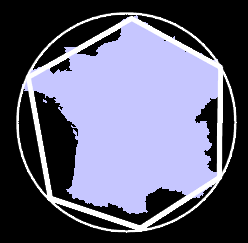Re: APOD: Saturns Hexagon and Rings (2013 Feb 20)
Posted: Wed Feb 20, 2013 6:14 pm
Hi, there is this picture to see its compared size to that of the Earth:


APOD and General Astronomy Discussion Forum
https://asterisk.apod.com/

Doug Stern wrote:
In the last year or three, CBC [Canadian radio] radio program Quirks and Quarks interviewed professor at Dalhousie University studying fluid dynamics, and he related how as one speeds up a liquid vortex, one gets a progression of shapes from triangle, square, pentagon, hexagon, etc as the vortex is speeded up. I contacted the professor re the hexagonal pattern on Saturn and he thought it could be explained by this process.
http://asterisk.apod.com/viewtopic.php?f=29&t=30276&p=188834#p188826 wrote:
<<The population of Flatland can "evolve" through the "Law of Nature", which states: "a male child shall have one more side than his father, so that each generation shall rise (as a rule) one step in the scale of development and nobility. Thus the son of a Triangle is a Square, the son of a Square is a Pentagon, the son of a Pentagon, a Hexagon; and so on.">>
http://en.wikipedia.org/wiki/Dalhousie_University wrote:<<Dalhousie University (commonly known as Dalhousie or Dal) is a public research university with three campuses in Halifax, Nova Scotia, Canada, and a fourth, the Dalhousie Agricultural Campus, in Bible Hill, Nova Scotia. It is one of Canada's oldest universities, founded during British colonial rule.
The current motto used by the university is Ora et Labora. The Latin motto is literally translated as "pray and work" and has been in use since 1870. The university had adopted the motto from the Earl of Dalhousie in order to replace the university's original motto, as the original motto was viewed by the university administration to not convey confidence. The original motto of the university was "Forsan". This Latin motto is literally translated as Perhaps and first appeared in the first Dalhousie Gazette of 1869. It was chosen from Virgil's epic poem Aeneid, Book 1, line 203, Forsan et haec olim meminisse iuvabit. The Latin motto is literally translated as "Perhaps the time may come when these difficulties will be sweet to remember".
A number of songs are commonly played and sung at various events such as commencement, convocation, and athletic contests, including the Carmina Dalhousiana.>>

Ron-Astro Pharmacist wrote:
It would be interesting if it reflected some structure underneath.
http://en.wikipedia.org/wiki/Hexagon_%28disambiguation%29 wrote:
The Hexagon (l' Hexagone) is an epithet of France, owing to the shape of its European mainland. A regular hexagon is depicted on France's one- and two-euro coins
The Hexagon is the name of the national military headquarters in Batman (TV series); compare with The Pentagon